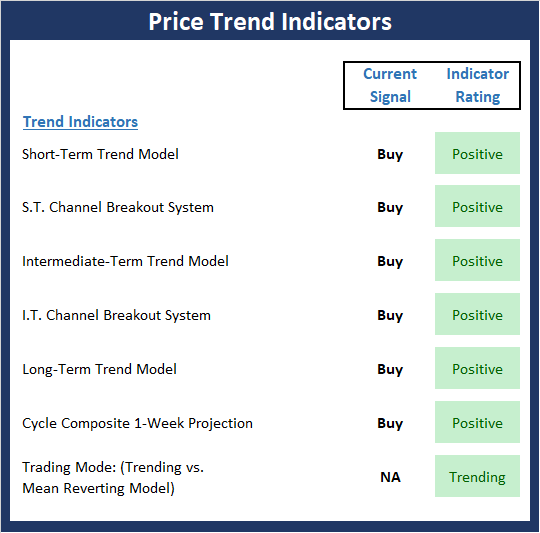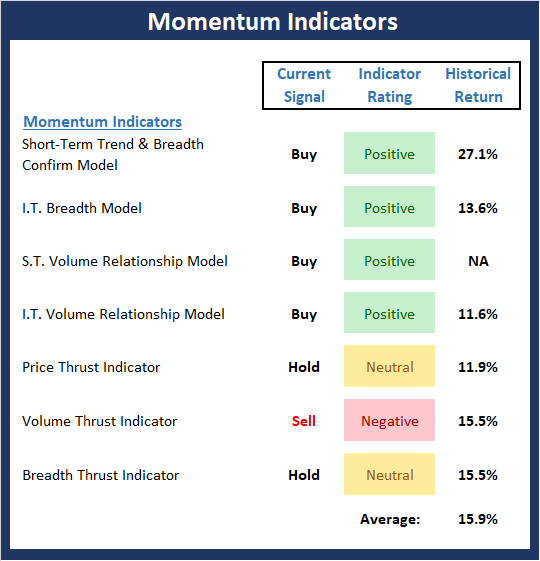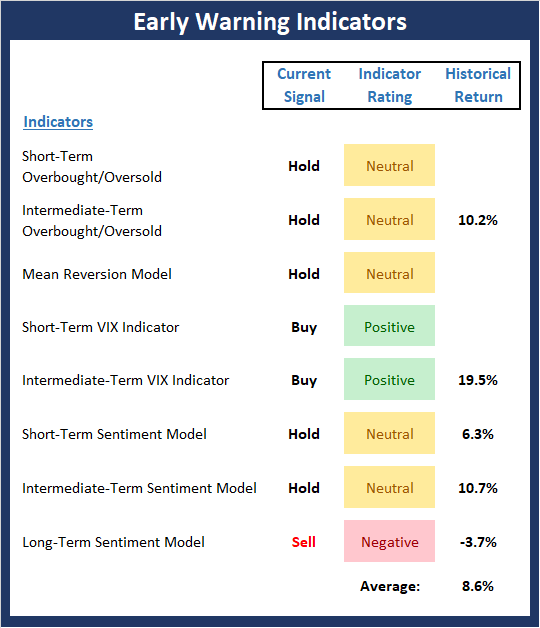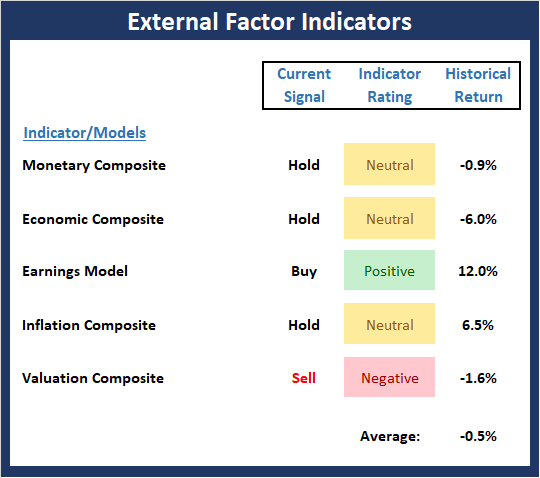All Is Not Right With The World
As you are likely aware, I have been suggesting that "some" caution has been warranted in the stock market for a while now. I have pointed to the "state" of both my Primary Cycle models (my favorite longer-term, big-picture market models - shown in the first indicator box below) and the External Factors Indicator board (last indicator box below) as exhibits A & B in my argument.
I've also thrown in seasonal weakness as another reason to perhaps take one's foot off the portfolio gas a bit here. You see, the August through September/Early-October period has displayed a tendency to be bumpy at times. And the simple fact of the matter is that historically, if/when the bears have taken control of the game, they have done so during this time frame an inordinate number of times.
Does this mean that stocks are destined to fall over the next 4-8 weeks? In a word, no. And with the S&P 500 a mere stone's throw from its January all-time high (0.79% to be exact), it would seem that the bulls are still large and in charge - especially given the news on Thursday/Friday that the U.S. and China may be starting to talk again.
What I am saying is it wouldn't surprise me IF (note the use of capital letters) the bears found a raison d'etre in here somewhere. Well, for month or two, anyway. Because if/when the bears get something going, they tend to do it when no one is looking, and when everybody is feeling pretty good about their investments.
Let's face it; people are upbeat about the stock market these days. The economy is going great. Unemployment is low. Earnings have been nothing short of impressive lately. Rates are still low enough to encourage business. The tax cuts are in. And business/investor sentiment is strong. What's not to like, right?
All May Not Be Right With The World Markets
One issue that I'm becoming increasingly concerned about is the idea that the best bull markets tend to be global in scope. Don't look now fans, but it might be worth noting that while the U.S. stock market appears to be 'doing just fine, thank you,' the rest of the world is not.
For example, the Eurozone (EZU) is down -14.5% from its January high. Japan (EWJ) has fallen -11.6%. China has dropped -12.5%. Germany (EWG) is down -17.1%. And the Emerging Markets ETF (EEM) is off -19.0%. (P.S. Turkey (TUR) has crashed -54.5% from its January high.)
Sure, we can blame it on the trade war. Or the financial crisis in Turkey. Or, the slowdown in the economies of the Eurozone and China. But, the bottom line is that things are not going well in many stock markets around the globe.
Digging a little deeper into the subject, I find that the number of sub-industry groups within the MSCI All Country World Index (representing 43 countries) that are technically healthy (I.E. in uptrends, with positive momentum) has been declining steadily since late January. And this, dear readers, is a sign of technical deterioration.
At the market peak in January, Ned Davis Research data shows that 82% of the sub-industry groups were technically healthy. Today, that number is 54. And according to NDR's database, over the last 30 years, the ACWI has lost ground at an annualized rate of -18.25% when the percentage of technically healthy sub-industry groups has been below 53. Compare this to the +20.6% annualized gains that have occurred when more than 77% of the sub-industry groups are healthy.
Thus, one can make the argument that a global bear market may even be underway. Such was the case in 2015/16 and 2011, which were the last two "mini" bear markets seen in stocks. Oh, and the last two times the percentage of ACWI sub-industry groups were below 53 was in 2011 and 2015/16.
The bull argument is that the U.S. doesn't need the support of global economies or stock markets. And to be fair, this may be turn out to be true. However, in my experience, things are much, much easier when the world markets are all rowing in the same direction.
The Takeaway
None of the above means that the bears are about to take control of Wall Street. But from my seat, it does mean that risks of a decline are elevated. And as a risk-manager, this is the time to play the game in a more conservative fashion. Of course, this means different things to different investors. But for me, it means having some dry powder on the sidelines that can be put to work when/if things get sloppy.
Now let's move on to the weekly review of my favorite indicators and market models...
INTRODUCING: THE ELEVATION STRATEGY
A Tax-Efficient Approach to Managing Risk in the Stock Market
Believed to be unique in the industry, the Elevation strategy is a long-term, risk-managed portfolio solution designed for growth-oriented investors seeking a tax-efficient, risk-managed approach to the stock market. Our tests show that 75% of the Strategy's profitable trades since 3/31/1999 would have qualified as long-term for tax purposes.
The State of the Big-Picture Market Models
I like to start each week with a review of the state of my favorite big-picture market models, which are designed to help me determine which team is in control of the primary cycle.

View My Favorite Market Models Online
The Bottom Line:
- The good news for the Primary Cycle board this week is the Risk/Reward model managed to move back up into the neutral zone. This causes the "look and feel" of the board to improve and the historical return of the S&P 500 for the current state of the models to move back up above the long-term average. But... there are still two sell signals on the board, which tells me to continue to keep my enthusiasm curbed, for now.
The State of the Trend
Once I've reviewed the big picture, I then turn to the "state of the trend." These indicators are designed to give us a feel for the overall health of the current short- and intermediate-term trend models.

View Trend Indicator Board Online
The Bottom Line:
- As you can tell by the all the bright green boxes, the Trend Board is in good shape. We should note however, that the cycle composite begins to turn down for the seasonally weak period week after next.
The State of Internal Momentum
Next up are the momentum indicators, which are designed to tell us whether there is any "oomph" behind the current trend.

View Momentum Indicator Board Online
The Bottom Line:
- The Momentum board remains in "pretty good" shape this week. However, we should note that the "thrust" indicators continue to struggle. This may be due to the fact that the volume and breadth indicators are based on the NASDAQ, which has seen some rotation away from tech of late. Yet, at the same time, the NAZ has been the leader of this parade for a very long time. Therefore, this remains something to watch.
The State of the "Trade"
We also focus each week on the "early warning" board, which is designed to indicate when traders might start to "go the other way" -- for a trade.

View Early Warning Indicator Board Online
The Bottom Line:
- The "Early Warning" board had been warning that a reversal was possible. However, with stocks following the news flow, the bears wound up back on the bench awaiting the next opportunity. Unfortunately for our furry friends, the board is largely neutral at this point.
The State of the Macro Picture
Now let's move on to the market's "external factors" - the indicators designed to tell us the state of the big-picture market drivers including monetary conditions, the economy, inflation, and valuations.

View External Factors Indicator Board Online
The Bottom Line:
- The External Factors board improved a bit this week as the Inflation Composite model managed to work back to neutral. But there can be no denying that this board isn't in great shape. The good news is the lone positive (earnings) is a biggie and is more influential on near-term price movement than the monetary or valuation components. But I continue to believe that this board is a reason for some caution here.
Publishing Note: I am traveling the rest of the week. My next report will be published on Monday morning.
Thought For The Day:
Every time you smile at someone, it is an action of love, a gift to that person, a beautiful thing. -Mother Teresa
Wishing you green screens and all the best for a great day,

David D. Moenning
Founder, Chief Investment Officer
Heritage Capital Research
HCR Focuses on a Risk-Managed Approach to Investing
What Risk Management Can and Cannot Do
ANNOUNCEMENT:
HCR Awarded Top Honors in 2018 NAAIM Shark Tank Portfolio Strategy Competition
Each year, NAAIM (National Association of Active Investment Managers) hosts a competition to identify the best actively managed investment strategies. In April, HCR's Dave Moenning took home first place for his flagship risk management strategy.
Disclosures
At the time of publication, Mr. Moenning held long positions in the following securities mentioned: EZU, EWJ - Note that positions may change at any time.
Indicators Explained
Short-Term Trend-and-Breadth Signal Explained: History shows the most reliable market moves tend to occur when the breadth indices are in gear with the major market averages. When the breadth measures diverge, investors should take note that a trend reversal may be at hand. This indicator incorporates NDR's All-Cap Dollar Weighted Equity Series and A/D Line. From 1998, when the A/D line is above its 5-day smoothing and the All-Cap Equal Weighted Equity Series is above its 25-day smoothing, the equity index has gained at a rate of +32.5% per year. When one of the indicators is above its smoothing, the equity index has gained at a rate of +13.3% per year. And when both are below, the equity index has lost +23.6% per year.
Channel Breakout System Explained: The short-term and intermediate-term Channel Breakout Systems are modified versions of the Donchian Channel indicator. According to Wikipedia, "The Donchian channel is an indicator used in market trading developed by Richard Donchian. It is formed by taking the highest high and the lowest low of the last n periods. The area between the high and the low is the channel for the period chosen."
Intermediate-Term Trend-and-Breadth Signal Explained: This indicator incorporates NDR's All-Cap Dollar Weighted Equity Series and A/D Line. From 1998, when the A/D line is above its 45-day smoothing and the All-Cap Equal Weighted Equity Series is above its 45-day smoothing, the equity index has gained at a rate of +17.6% per year. When one of the indicators is above its smoothing, the equity index has gained at a rate of +6.5% per year. And when both are below, the equity index has lost -1.3% per year.
Cycle Composite Projections: The cycle composite combines the 1-year Seasonal, 4-year Presidential, and 10-year Decennial cycles. The indicator reading shown uses the cycle projection for the upcoming week.
Trading Mode Indicator: This indicator attempts to identify whether the current trading environment is "trending" or "mean reverting." The indicator takes the composite reading of the Efficiency Ratio, the Average Correlation Coefficient, and Trend Strength models.
Volume Relationship Models: These models review the relationship between "supply" and "demand" volume over the short- and intermediate-term time frames.
Price Thrust Model Explained: This indicator measures the 3-day rate of change of the Value Line Composite relative to the standard deviation of the 30-day average. When the Value Line's 3-day rate of change have moved above 0.5 standard deviation of the 30-day average ROC, a "thrust" occurs and since 2000, the Value Line Composite has gained ground at a rate of +20.6% per year. When the indicator is below 0.5 standard deviation of the 30-day, the Value Line has lost ground at a rate of -10.0% per year. And when neutral, the Value Line has gained at a rate of +5.9% per year.
Volume Thrust Model Explained: This indicator uses NASDAQ volume data to indicate bullish and bearish conditions for the NASDAQ Composite Index. The indicator plots the ratio of the 10-day total of NASDAQ daily advancing volume (i.e., the total volume traded in stocks which rose in price each day) to the 10-day total of daily declining volume (volume traded in stocks which fell each day). This ratio indicates when advancing stocks are attracting the majority of the volume (readings above 1.0) and when declining stocks are seeing the heaviest trading (readings below 1.0). This indicator thus supports the case that a rising market supported by heavier volume in the advancing issues tends to be the most bullish condition, while a declining market with downside volume dominating confirms bearish conditions. When in a positive mode, the NASDAQ Composite has gained at a rate of +38.3% per year, When neutral, the NASDAQ has gained at a rate of +13.3% per year. And when negative, the NASDAQ has lost at a rate of -8.18% per year.
Breadth Thrust Model Explained: This indicator uses the number of NASDAQ-listed stocks advancing and declining to indicate bullish or bearish breadth conditions for the NASDAQ Composite. The indicator plots the ratio of the 10-day total of the number of stocks rising on the NASDAQ each day to the 10-day total of the number of stocks declining each day. Using 10-day totals smooths the random daily fluctuations and gives indications on an intermediate-term basis. As expected, the NASDAQ Composite performs much better when the 10-day A/D ratio is high (strong breadth) and worse when the indicator is in its lower mode (weak breadth). The most bullish conditions for the NASDAQ when the 10-day A/D indicator is not only high, but has recently posted an extreme high reading and thus indicated a thrust of upside momentum. Bearish conditions are confirmed when the indicator is low and has recently signaled a downside breadth thrust. In positive mode, the NASDAQ has gained at a rate of +22.1% per year since 1981. In a neutral mode, the NASDAQ has gained at a rate of +14.5% per year. And when in a negative mode, the NASDAQ has lost at a rate of -6.4% per year.
Short-Term Overbought/sold Indicator: This indicator is the current reading of the 14,1,3 stochastic oscillator. When the oscillator is above 80 and the %K is above the %D, the indicator gives an overbought reading. Conversely, when the oscillator is below 20 and %K is below its %D, the indicator is oversold.
Intermediate-Term Overbought/sold Indicator: This indicator is a 40-day RSI reading. When above 57.5, the indicator is considered overbought and when below 45 it is oversold.
Mean Reversion Model: This is a diffusion model consisting of five indicators that can produce buy and sell signals based on overbought/sold conditions.
VIX Indicator: This indicator looks at the current reading of the VIX relative to standard deviation bands. When the indicator reaches an extreme reading in either direction, it is an indication that a market trend could reverse in the near-term.
Short-Term Sentiment Indicator: This is a model-of-models composed of 18 independent sentiment indicators designed to indicate when market sentiment has reached an extreme from a short-term perspective. Historical analysis indicates that the stock market's best gains come after an environment has become extremely negative from a sentiment standpoint. Conversely, when sentiment becomes extremely positive, market returns have been subpar.
Intermediate-Term Sentiment Indicator: This is a model-of-models composed of 7 independent sentiment indicators designed to indicate when market sentiment has reached an extreme from an intermediate-term perspective. Historical analysis indicates that the stock market's best gains come after an environment has become extremely negative from a sentiment standpoint. Conversely, when sentiment becomes extremely positive, market returns have been subpar.
Long-Term Sentiment Indicator: This is a model-of-models composed of 6 independent sentiment indicators designed to indicate when market sentiment has reached an extreme from a long-term perspective. Historical analysis indicates that the stock market's best gains come after an environment has become extremely negative from a sentiment standpoint. Conversely, when sentiment becomes extremely positive, market returns have been subpar.
Absolute Monetary Model Explained: The popular cliché, "Don't fight the Fed" is really a testament to the profound impact that interest rates and Fed policy have on the market. It is a proven fact that monetary conditions are one of the most powerful influences on the direction of stock prices. The Absolute Monetary Model looks at the current level of interest rates relative to historical levels and Fed policy.
Relative Monetary Model Explained: The "relative" monetary model looks at monetary indicators relative to recent levels as well as rates of change and Fed Policy.
Economic Model Explained: During the middle of bull and bear markets, understanding the overall health of the economy and how it impacts the stock market is one of the few truly logical aspects of the stock market. When our Economic model sports a "positive" reading, history (beginning in 1965) shows that stocks enjoy returns in excess of 21% per year. Yet, when the model's reading falls into the "negative" zone, the S&P has lost nearly -25% per year. However, it is vital to understand that there are times when good economic news is actually bad for stocks and vice versa. Thus, the Economic model can help investors stay in tune with where we are in the overall economic cycle.
Inflation Model Explained: They say that "the tape tells all." However, one of the best "big picture" indicators of what the market is expected to do next is inflation. Simply put, since 1962, when the model indicates that inflationary pressures are strong, stocks have lost ground. Yet, when inflationary pressures are low, the S&P 500 has gained ground at a rate in excess of 13%. The bottom line is inflation is one of the primary drivers of stock market returns.
Valuation Model Explained: If you want to get analysts really riled up, you need only to begin a discussion of market valuation. While the question of whether stocks are overvalued or undervalued appears to be a simple one, the subject is extremely complex. To simplify the subject dramatically, investors must first determine if they should focus on relative valuation (which include the current level of interest rates) or absolute valuation measures (the more traditional readings of Price/Earnings, Price/Dividend, and Price/Book Value). We believe that it is important to recognize that environments change. And as such, the market's focus and corresponding view of valuations are likely to change as well. Thus, we depend on our Valuation Models to help us keep our eye on the ball.
Disclosures
The opinions and forecasts expressed herein are those of Mr. David Moenning and may not actually come to pass. Mr. Moenning's opinions and viewpoints regarding the future of the markets should not be construed as recommendations. The analysis and information in this report is for informational purposes only. No part of the material presented in this report is intended as an investment recommendation or investment advice. Neither the information nor any opinion expressed constitutes a solicitation to purchase or sell securities or any investment program.
Any investment decisions must in all cases be made by the reader or by his or her investment adviser. Do NOT ever purchase any security without doing sufficient research. There is no guarantee that the investment objectives outlined will actually come to pass. All opinions expressed herein are subject to change without notice. Neither the editor, employees, nor any of their affiliates shall have any liability for any loss sustained by anyone who has relied on the information provided.
Mr. Moenning may at times have positions in the securities referred to and may make purchases or sales of these securities while publications are in circulation. Positions may change at any time.
The analysis provided is based on both technical and fundamental research and is provided "as is" without warranty of any kind, either expressed or implied. Although the information contained is derived from sources which are believed to be reliable, they cannot be guaranteed.
Investments in equities carry an inherent element of risk including the potential for significant loss of principal. Past performance is not an indication of future results.

